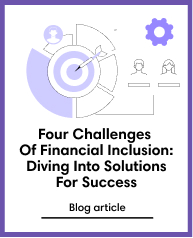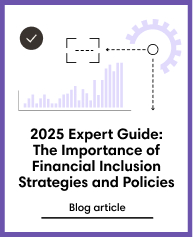Financial Inclusion
Jan 27, 2020
CredoLab's largest market: Indonesia
Subscribe to our newsletter
Financial technology or fintech adoption is on the rise in several developing countries across the world, spurred by the growing adoption of digitization, artificial intelligence (AI), and big data analytics. While traditional banks and financial institutions have struggled to close the gap in financial inclusion for decades, Fintech startups are bringing more unbanked customers into the credit fold for the very first time, enabling speedy credit approvals and easier financial transactions. Indonesia is one such growing hot spot for the fintech industry in East Asia.
Today, Indonesia is the world’s 16th largest economy, and is projected to become the seventh largest by 2030. There are more than 50 million micro, small, and medium-sized enterprises (MSMEs) in Indonesia but 70% of them lack access to bank financing. Propelled by a huge need gap and other factors including the growing number of skilled workers, increasing internet penetration, rise of digital initiatives by state-owned banks, the fintech market is expected to soar in this Southeast Asian country. According to the Indonesian consultancy firm Cekindo, there were over 150 fintech firms launched in Indonesia as of late 2018, a 78% increase since 2015.
The FinancialServices Authority (OJK)’s role in overseeing the Indonesian fintech market
The Financial Services Authority (OJK) is one of three primary public entities, including Bank Indonesia (BI) and theCommodity Futures Trading Regulatory Agency (BAPPEBTI), tasked with overseeing the growth of the fintech sector in Indonesia. The OJK is responsible for regulating and supervising the policies and activities of the financial services sector. As of February 2019, there were 99 licensed and registered peer-to-peer (P2P) lenders according to OJK. Until September 2018, OJK’s regulations were limited to only P2P lenders, although its purview has since been expanded to cover all fintech firms.
The latest OJK regulations stipulate that any fintech firm engaged in financial services activities such as transaction settlements, capital accumulation, investment management, fund distribution and collection, insurance and market support services are deemed to register with the OJK. The OJK will also regulate the level of innovation, use of ICT, support of financial inclusion and literacy, public benefit and accessibility. OJK also oversees fintech companies’ reporting practices and data protection procedures.
The OJK is also tasked with ensuring that the fintech market overcomes current challenges that are hindering its growth. TheIndonesian fintech market faces two primary challenges at present. The first being the persistent low level of financial inclusion. The E&Y census of2018 reports that despite high internet penetration in the country, national digital channel knowledge is at 34%and digital channel usage is a mere 8.7%. The second major challenge is the $165 billion wide credit gap for MSMEs.
Indonesian government's efforts to drive financial inclusion
The vision and mission of Indonesia’s National strategy for Financial Inclusion is described as “To achieve a financial system that is accessible by all layers of the community to promote economic growth, poverty reduction, income equality, and creation of financial system stability in Indonesia”, in the financial booklet released by Financial Access and the SME Development Department ofIndonesia in 2014. The strategy is designed with an aim to achieve the following six objectives:
· Make financial inclusion a part of the grand strategy of economic development, poverty
reduction, equal income distribution, and financial system stability.
· Provide financial services and products tailored to the needs of the community.
· Improve people’s knowledge on financial services.
· Improve people’s access to financial services.
· Strengthen the synergy between banks, micro finance institutions, and non banking
financial institutions.
· Optimize the role of information and communication technology (ICT)to expand the scope
of financial services.
The relevant ministries and institutions have introduced several initiatives to implement the National Strategy for FinancialInclusion. This exemplifies the commitment of the Indonesian government to actively lead efforts to increase financial inclusion. The Bank Indonesia also supports the National Strategy for Financial Inclusion through coordinating activities related to financial inclusion, mapping regional areas with potential for holding such activities and programs, disseminating financial inclusion programs, etc.
The need for credit risk management
A 2018 PWC survey listed Non-Performing Loans(NPLs) and credit risk management as the largest concerns of Indonesian bankers and lenders working to stabilize growth. The onus of mitigating the risk of another financial crisis and protecting all the stakeholders by limitingNPLs lies with the central bank, regulatory agents, and banking firms. To ensure stability and long-term economic growth while giving the fintech market a much needed boost, the OJK has established regulations on loan provisioning and internal credit risk management. However, experts recommend promoting credit-score institutes and a higher usage of credit scores to determine the credit clearing capacity of individuals.
With the growing demand for fintechs to drive financial inclusion, backed by support from the Indonesian government and public banks to ensure stable economic growth, Indonesia promises immense opportunity for fintechs such as CredoLab. As a leading Credit scoring platform, CredoLab has the necessary resources and expertise to assist banks and other FIs to set up a credit score mechanism through AI-based predictive algorithms. The firm uses non-intrusive and anonymous metadata to score customers, which means better credit scoring without compromising customer privacy, something that the Indonesian financial policy makers are also focusing on while promoting economic growth, poverty reduction and income equality.





